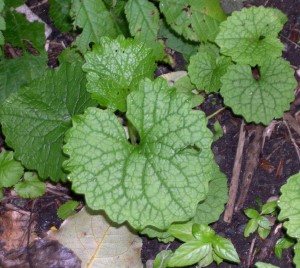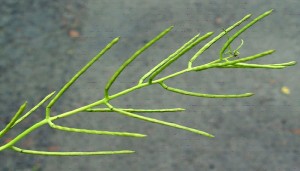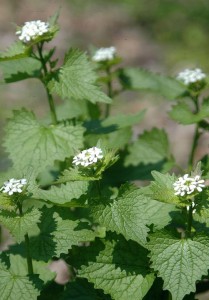Garlic Mustard
Alliaria Petiolata
Garlic Mustard
Native Origin: Europe and Asia. Brought to North America in the 1860s, garlic mustard had long been used by Europeans as a flavoring herb and for limited medicinal purposes. Also known as “Sauce-Alone” and “Jack-by-the-Hedge”, garlic mustard occurs throughout the eastern U.S. and Canada. Leaves and stems smell of garlic when crushed.
Habitat & Ecological Impact: Thrives in moist shaded soils of floodplains, forests and roadsides. Disturbed areas are most susceptible to rapid invasion. Seeds may continue to ripen even on cut stems. Seeds are easily transported in muddy soils clinging to equipment tires, animal feet and hooves and humans’ shoes. Prolific seeds can persist in soils for up to 10 years. Plants produce root toxins that inhibit growth of other species. Once introduced to an area, garlic mustard monopolizes light, moisture, soil and space and quickly out-competes and eliminates native wildflowers, grasses and tree and shrub seedlings. Although deer do not eat garlic mustard, they may encourage plant growth by eating and removing native plants and by disturbing adjacent soils. While butterflies may nectar on the flowers, their larvae cannot eat the leaves.
Description: A biennial herb, garlic mustard produces a low-growing rosette of green leaves in its first year and only flowers in the second year. Flowering plants are 2 to 3 ½ feet tall, with clusters of small white flowers produced in early spring. Like most plants in the mustard family, each flower has four petals arranged in the shape of a cross. The long, slender seedpods are produced in May. Once mature, the long brown pods persist through summer, holding shiny black seeds up to several thousand per plant.
Control & Management: Careful monitoring and repeat control is required over several years.
Manual: Light infestations can be hand-pulled, taking care to remove all roots. When flowers or seed stalks are present, all plant parts should be bagged and removed from the area.
Mechanical: If flowering stalks are cut at ground level, seed production will be reduced or even eliminated. All stalks should be bagged and removed from the area.
Chemical: Heavy infestations may be treated with foliar applications of systemic herbicide (Roundup). Great care should be taken to avoid non-target plants; repeat applications may be needed as long-lived seeds sprout.
Comments are currently closed.



